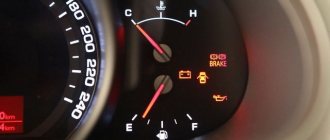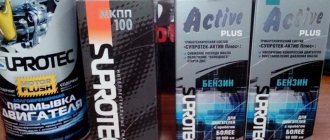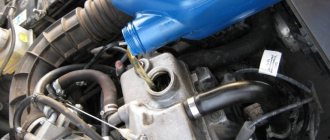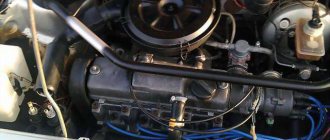The operation of an internal combustion engine requires the use of an anti-wear fluid - motor oil. The service life and power characteristics of the vehicle largely depend on it. Motor oil constantly circulates through the channels of the system, removes heat, and lubricates the mechanisms. Due to this, it is mixed, partially cooled and partially heated. The temperature of the engine oil is constantly changing. What should it be like for the system to work properly? Let's try to figure it out.
Engine oil and engine temperature
Lubricating fluid is an important component for the operation of any engine. The document defining the classification and designation of oils used in internal combustion engines is the interstate standard GOST 17479-85, as amended in 1999. The requirements of this document are interrelated with the international standards SAE, API and ACEA, which determine the parameters of oils depending on the season and ambient temperature. The SAE standard defines the viscosity-temperature characteristics of a lubricant. The API standard specifies the use of lubricant, depending on the type of engine, its production date and technical parameters (for example, with or without turbocharging). The ACEA standard was developed by European manufacturers. It is similar to the API standard, but has more stringent indicators.
Based on these documents, motor oil can be gasoline, diesel and universal. The oil solution is made from mineral oil with the addition of various components and additives. Depending on the additives, the oil fluid in the engine unit is divided into: mineral, synthetic and semi-synthetic.
According to its structure, the oil solution is divided into three types:
- Winter. A special feature is its more liquid state, which makes it easier to start the car. During the warm season, the oil solution is not suitable for use, since during operation its viscosity will become less than the standard. The functions of protecting and lubricating units will be reduced to a minimum. Has alphanumeric markings.
- Summer. Used at ambient temperatures above zero degrees. This liquid has a high viscosity and fluidity. Use in winter is not recommended, as the high viscosity will make starting the vehicle difficult. Has digital markings.
- All-season. The most popular type of fluid among all drivers. Can be used at any time of the year at any ambient temperature. Has double marking.
The choice of oil has a direct impact on engine temperature. The operating temperature of the power plant ranges from 70 to 90 degrees in winter. As the temperature rises to zero, you can start driving when the engine warms up to 50-70 degrees. In summer, components and assemblies do not need to be warmed up. You can start moving in natural conditions. At the recommended temperature conditions, the engine starts and runs reliably, and the cylinders are filled to the maximum extent. Some types of starters have a normal operating mode at temperatures from 100 to 110 degrees. Basically, this is a wound air-cooled unit, for example a two-stroke engine.
What to do if the oil boils?
If you are stuck in a traffic jam or in a parking space and notice oil burning, turn off the engine immediately. There is no need to panic, the main thing is to stop the engine.
If smoke appears from the engine compartment while driving, stop the car as follows:
- Minimize the load on the power plant - to do this, take your foot off the gas pedal to lower the speed.
- Turn on the car heater to maximum airflow - this will remove some of the overheated air from the working area and reduce its concentration in the engine.
- If road conditions permit, coast until the vehicle comes to a complete stop. The oncoming wind will cool the engine compartment.
- As soon as the car stops, wait another 5 minutes and only then turn off the engine.
Remember! When the temperature inside the propulsion system increases, sudden braking of the vehicle should not be allowed.
How does the engine lubrication system work?
The task of the lubrication system is to store, transport, clean and supply oil to the rubbing parts of the engine in order to reduce friction of mating parts, ensure a smooth start of the engine and prevent it from overheating. The task is accomplished by a complex of components and assemblies, which includes:
- Engine crankcase (sump) with drain neck.
- Oil pump.
- Oil filter.
- Radiator for cooling oil fluid.
- Pressure reducing valve.
- Pressure meter.
- Temperature sensor.
- Pipelines.
The dangers of oil overheating
Excessive heating of the lubricant is much more dangerous than the previous case. Until the operating temperature of the oil leaves the permissible limits, parts operating in the hydrodynamic lubrication mode (crankshaft connecting rods and main journals) do not have mechanical contact with each other.
After heating the oil above 105°C, its viscosity decreases and it becomes more fluid. In this case, under the influence of load, the oil gap loses its load-bearing capacity, and the interacting parts come into contact.
Read also: How to connect an Android to a Pioneer radio
From this moment, due to friction, the rubbing parts begin to heat up, and the thermal gap between them decreases. Increasing oil temperature leads to its oxidation, which theoretically can be detected using laboratory analysis. When the oil heats up above 125°C, it becomes so fluid that it seeps through the oil scraper rings and penetrates into the working cavity of the cylinder, where it burns out.
Due to increasing consumption, oil has to be topped up, in which case all oil additives are renewed, and the analysis results are unreliable. The engine begins to wear out intensively, but this is often attributed to poor performance of the lubrication system.
And only after the engine breaks down can you discover what reason contributed to the sad outcome. If there was an oil starvation, the oil pump would be damaged, and the pistons could be scored. And in this case, the pump is working, but the crankshaft journals are raised.
Concluding the article, I would like to advise drivers who want to maintain the health of their iron “horse” to avoid long-term driving at high speeds, monitor the temperature of the engine oil, replace it in a timely manner and fill in a proven product with the viscosity recommended by the automaker.
The topic of oil operating temperature, its overheating, optimal viscosity for each individual engine is becoming increasingly relevant (hello to heat-loaded engines, those who like to boost their engines, and just everyone who periodically piles on). I also remember, of course, my experience with a 1.4 engine with combined supercharging, where the topic of increased oil temperatures is associated with the low reliability of this unit. Therefore, I present some excerpts from the discussion of these issues; I tried to highlight the most significant points in bold; in my opinion, useful and interesting information.
The ideal oil viscosity at engine operating temperature (measured in the drain pan) should be about 10 cst plus or minus 2 units for all piston engines in principle. This is due to the materials from which these engines are made, their fundamental design, thermal expansion gaps, as well as oil films... if the engine only heats up to 90g, then the oil needed is 20k at 100g - 30k at 110g - 40k about this pitch indexes 50 and 60 are purely sports oils, not for regular engines
under normal conditions, if everything is in order with all systems and radiators, then the calculated Tmasla usually does not exceed +10g, if it exceeds, then there is a problem somewhere
- “hot” index 40 means that at 100 degrees. the oil has 14 cSt, but this is the same oil in the pan at 90 degrees. will have 18 cSt (as if at CAE 50), at 130 g - 11 cSt (index 30) - a real viscosity of 10 cSt is ideal for any modern engine (in general) at any operating temperature
- with such a viscosity, empirically, the motor has time to lubricate everywhere - in all its friction pairs
- with a higher viscosity for a given mode of operation of the motor, the friction pairs will not have time to be lubricated, with a lower viscosity - they will not have time to create a film on the friction pairs
- in other words, as it were the engine has not warmed up, the viscosity should be around 10 cSt for a given temperature - the trick is to determine what temperature the oil in your engine will be at most of the time and this is the viscosity that needs to be selected
- if your engine heats the oil up to 100 degrees, then the ideal would be to fill it with index 30 - just at 100 degrees. you will have the required viscosity - if your engine heats the oil to 130 degrees, then what oil at this temperature will give 10 cSt? The answer is with the CAE index 50
What are the catches here:
- if you fill your engine with index 50, but heat the oil only to 100 degrees, then at 100 degrees. The viscosity of your oil will be 18 cSt! It's too much! Too “thick” oil! it will not have time to lubricate all friction pairs with the frequency required by the cycles in which contact occurs in the PT - it will not reach them on time = power loss (due to friction), increased fuel consumption, clogging of chemical oils. products of the motor (many of which, by the way, do not stop in the filter, as many people think, because their molecular weight is too small to be caught by the MF curtain)
- if you fill your engine with index 30, but heat the oil to 130 degrees, then it will be too “light” - its viscosity will be lower than the required 10 cSt, it will “whistle” between the friction pairs, and will not give a film in the PT that is strong enough shear, protecting the engine from loss of power (fuel)
* for reference - heating up to 130 degrees is a standard value for sports engines (racing engines, so that there are no illusions, not sraker ones)
For example: a viscosity of 15 cSt occurs at: * 5W40 at 90 degrees * 10W40 at 99 degrees * 10W50 at 109 degrees * 10W60 at 119 degrees
a viscosity of 10 cSt occurs at: * 5W40 at 117 degrees * 10W40 at 118 degrees * 10W50 at 130 degrees * 10W60 at 142 degrees
Conclusion: if you have the opportunity to cool the oil to a constant operating temperature of 105-110 or at least 115 degrees, take advantage of it to use oil with the lowest possible “hot” index. This will give a real increase in engine power.
Read also: What is the absolute pressure in the intake manifold
Example: Here are the power measurements for different synthetics (the same engine and everything else, of course!): * 15W50 = 228 hp. * 5W40 = + 2.8% * 0W20 = + 5% to 15W50
There is one more point. If the normal operating temperature of the oil in a factory engine is, for example, 105-110 degrees and the standard oil for it is 40 degrees (and ideally 30 degrees, no matter how paradoxical it may sound for some), but in fact the engine is filled with 50 degrees or even 60, then it will overheat, because. The oil at operating temperature will be too thick and the engine will stupidly waste some of its power to pump it and, because of this, overheat above normal.
Simple physics.
At the Nissan club, even athletes were involved in disputes over the viscosity of oils. We found out that in their REALLY SPORTS engines, 99% of their time living in the 4500-6500 rpm zone, they pour oil no higher than 40 index. And in civilian ones - the usual 30s - patriotic leaders carried out experiments, throwing a sensor into the pan and measuring the oil temperature. And then they looked up the manual from the 1960s, where they found out that even then the plant recommended using low-viscosity oils with an index of 30 for gasoline engines)) I have a diesel engine, it has a working speed. In general, 84-90g, and the 20ka is ideal for it, which I’ve been riding on for four years now. It should not be 110g in quiet mode. They don't make STANDARD motors like this. because there is no technical sense in making such hot engines. this will require the use of a bunch of expensive materials, but they still strive to reduce the cost. it's just not profitable.
The coolant system is normally designed for 90g of coolant, the oil cooling system is approximately +10g to it. The oil must circulate very quickly through the system, because it not only lubricates, but also cools the friction pairs. If, during a single acceleration, the oil suddenly jumps to 120, then something is wrong either with its circulation or with cooling.
in fact, you can give in at 30k, of course, with a fully functional cooling system, both oil and coolant 40k is needed if you are already ready to go straight to the ring, or run continuously along the passes for half an hour/hour, i.e. it’s realistic to spin the engine CONSTANTLY 90% of the time in the zone above 4500 rpm, and if so, give it 15-30 seconds, then remove the load and just “fly” further at constant speeds - and 30 is enough for the eyes.
The oil temperature can vary greatly from place to place. I'll say this. Any rapid overheating leads to “fatigue” of the oil.
In other words, in many engines the oil drains from the cylinder head close to the wall of the exhaust manifold. And as it would be said trivially, when the oil flows past this hot spot for less than 0.1 sec, it “spoils.” Each oil has its own flash point and operating temperature. Therefore, to say what the temperature of your oil should be - it all depends on your oil. Experience says that do not allow the oil temperature ANYWHERE in the engine to exceed 105. On the one hand, this is terribly difficult. Hold it - the motor will live many times longer and will not lose its properties much longer. The oil shouldn’t be 125, much less 135 degrees, if you have a competent approach.
By the way, whoever installed the radiator on oil, the oil system began to work much louder, straining the nerves, although the pressure remains normal. The temperature, of course, drops and no more than 100. If the oil cooler is running loudly, it means the throughput is lower than that of the standard one. This means you need a cooler with a larger flow area than was installed, or with less flow resistance.
Preferably copper and with small honeycombs, then put a fan on it, connect the fan through the oil temperature sensor, for example, so that it turns on at 105.
The operation of an internal combustion engine requires the use of an anti-wear fluid - motor oil. The service life and power characteristics of the vehicle largely depend on it. Motor oil constantly circulates through the channels of the system, removes heat, and lubricates the mechanisms. Due to this, it is mixed, partially cooled and partially heated. The temperature of the engine oil is constantly changing. What should it be like for the system to work properly? Let's try to figure it out.
Functionality of lubricating fluids
In order for the power unit to function stably, it is necessary to select the correct lubricant solution. Its selection is made according to parameters, the main of which are:
- Viscosity. The main indicator of any oil. It means the ability of an oil fluid to maintain the proper level of fluidity while covering parts inside the engine. The degree of viscosity depends on the engine temperature and its own. As the temperature rises, the viscosity level drops.
- Viscosity index. A value that determines the level of viscosity of a lubricant solution depending on its temperature. Increasing the viscosity index increases the temperature range in which it can operate. The indicator is different for each type of oil.
- Flash temperature reading. A value that determines the level of low-boiling fractions in the oil liquid. In high-quality oils, flash occurs at temperatures of +230 degrees and above. If the oil solution is of poor quality, then low-viscosity components will quickly burn out and evaporate, and its consumption will increase.
- Boiling temperature reading. An indicator at which an oil fluid loses its viscosity and lubricating properties. Its boiling will lead to contact between the rubbing parts of the power plant and its failure.
- Ignition temperature reading. The amount of critical heating of the oil fluid. Its combustion begins when its temperature reaches +260 degrees. Ignition threatens to cause the engine to explode and cause injury to passengers.
- Volatility. The oil solution begins to evaporate at a temperature of +250 degrees. Determination of volatility is carried out using the NOC method. At the specified temperature, one liter of oil must be boiled for one hour. If after an hour there are 900 grams of liquid left, then the volatility level is 10%. According to international standards, this norm should not exceed 15%.
- Freeze temperature reading. A value that determines the level of loss of fluidity of an oil fluid. When the pour point is reached, the viscosity of the lubricant increases sharply or a process of increasing viscosity occurs with the solidification of paraffin, as a result of which the lubricant hardens.
- Alkaline TVN value. A number that determines the alkaline characteristics of the oil obtained as a result of the addition of detergent and degrading additives. This is an indicator of the ability of an oil fluid to neutralize harmful impurities and acids resulting from the operation of the power plant. A decrease in the alkaline index indicates a decrease in the number of active additives, which can lead to corrosion of the internal parts of the power plant.
- Acid number TAN. An indicator that determines the presence of oxidation elements in the lubricant. An increase in acid number indicates the presence of a large number of oxidation products. The acid number is determined when selecting oil for analysis. Typically, an increased acid value is associated with prolonged operation or high operating temperature of the power plant.
Main functions of motor oils
A car engine has many components and parts. Their surfaces are constantly in contact, creating friction between themselves. The result of this phenomenon is increased wear. In addition, friction consumes a significant portion of the engine's efficiency, which is converted into heat.
High temperatures provoke expansion of the materials from which the parts are made. Expansion processes are accompanied by a decrease in the gap between the contacting surfaces. There will come a time when this gap simply disappears, and the internal combustion engine will jam - this is what will happen if the unit operates without engine oil.
Engine oil performs a vital function, without which the unit simply cannot operate. It reduces the coefficient of friction by forming a thin oil film between contacting surfaces. In addition, lubricant increases engine efficiency and reduces wear of parts, promotes less heat generation, and also effectively removes it from rubbing surfaces. In addition to these functions, others are implemented:
- By-products of fuel combustion - soot, slag and other deposits - are actively removed thanks to detergent (washing) additives.
- Anti-corrosion protection prevents premature destruction of engine parts from corrosion.
- Dispersing - stabilizing components allow you to remove microscopic insoluble particles by adsorbing them into your composition. They are suspended and removed from the working fluid by a filter.
- The lubricating composition has approximately the same viscosity over a wide temperature range, which is very important for the normal functioning of the engine. This is achieved by using viscosity modifiers or thickening additives. They increase such a parameter as the viscosity index.
- Foaming of a liquid is a very dangerous process that leads to oil starvation of engine parts. To prevent this from happening, anti-foam additives are added to the lubricant composition.
- Depressant additives ensure low viscosity and good fluidity of the oil composition at low temperatures, which allows you to start the engine without problems and lubricate it well until it warms up.
The hydraulic fluid can also be controlled by pressure on hydraulic valve lash adjusters, hydraulic timing belt tensioners, and variable valve timing systems.
Engine oil operating temperature
The lubricant, depending on its characteristics, can be used in the temperature range from - 50 to + 170 degrees. The operating temperature of the oil in a warm engine and the preservation of its viscosity-technical parameters depend on the temperature regime of the engine. Normal engine temperature ranges from + 80 to + 90 degrees. With such heating, the starting unit has maximum efficiency. Oil lubricant warms up 10-15 degrees more than coolant. Therefore, the operating temperature of engine oil in a warm engine ranges from + 90 to + 105 degrees. It is not recommended to exceed the upper value. This threatens the lubricant with loss of characteristics and rapid wear of rubbing parts.
Symptoms of oil burning
There are four main symptoms of lubricant boiling. Among them:
change in thermostat readings. Each car is equipped with a special indicator on the dashboard, with which the driver can always monitor the temperature of the engine lubricant. When the engine is well warmed up, the indicator needle should point to the average value (small deviations - no more than one division - are permissible in both directions). But as soon as the vehicle owner noticed that the arrow was slowly but surely creeping towards the red line, then it was time to sound the alarm - the temperature of the car oil began to rise. the sound of boiling. Not in all, but in many cases, when such a problem occurs, a sound characteristic of boiling oil occurs. It is impossible to confuse it with anything. smoke. Another symptom of a critical increase is smoke billowing from the engine compartment.
Please note that its appearance can signal not only boiling oil, but also boiling coolant. In the latter case, it will be localized mainly in the area of the tank intended for filling antifreeze or antifreeze. black exhausts
If you did not notice the first three symptoms, or for some reason they did not form, but the oil temperature increased excessively, then the exhaust gas will begin to turn blue-black. Its intensity will increase, and it will be impossible not to notice it.
Changes in engine oil temperature
Engine parts are designed to expand when heated and return to their original state as the engine cools. The operation of the power unit depends on the temperature of the oil in a running engine. Excessively low or high heating of the oil in a running engine has negative consequences.
The low temperature of the lubricant can be considered + 80 degrees. With this indicator, the efficiency of the power plant decreases and its service life decreases. The parts of the power unit will have a slight expansion, which will lead to the formation of gaps between them and a decrease in compression. When the starter is slightly warmed up, moisture can condense and form acids in the lubricant, which will affect the wear of components and assemblies. Low degrees can cause the lubricant to thicken and freeze. This will affect its passage through the filter, creating a vacuum in the lubrication system and difficulties in the operation of the power plant.
High heat is even more dangerous than low heat. Heating the oil fluid above + 105 degrees leads to its viscosity sharply decreasing and fluidity increasing. Under load, the gap between the parts almost disappears, the parts of the crank mechanism come into contact with each other.
Negative phenomena in internal combustion engines due to thermal disturbances
The cause of aging of motor oil is the oxidation processes of hydrocarbon group elements occurring in the oil base. In this case, reaction products are released in the form of various deposits: carbon deposits, varnishes, sludge deposits. Temperature conditions have the greatest influence on this.
Soot is a solid substance in the form of soot, which is a product of the oxidation of hydrocarbons. This also includes unburned fuel elements (iron, lead), as well as various mechanical impurities. Carbon deposits cause all sorts of disruptions to the normal working process (detonation, glow ignition and some others).
Varnish is the result of oxidation of the oil film covering the contacting surfaces under the influence of high temperature in the combustion chamber. Up to 80% of its volume is carbon, the rest is oxygen, hydrogen and ash. The varnish coating impairs heat transfer through the oil film and leads to dangerous overheating of the piston and cylinder. The most dangerous is varnish deposits in the piston grooves, leading to ring sticking due to “coking”. The latter is a symbiosis of soot and varnish film.
Sludge is a mixture of products of low-temperature oxidation of carbon compounds with aqueous and emulsion contaminants. The reasons for their occurrence are: insufficient engine temperature, low oil quality, engine design features, as well as operating mode.
Viscosity-temperature characteristics
According to interstate standard 17479.1-85, oils are divided according to viscosity, purpose and performance indicators. Based on viscosity, lubricants are divided into winter and summer classes. The class has a numerical designation; the letter “z” is added to the winter class.
According to their intended purpose, oil fluids are divided into groups that determine the operating mode of power units, with appropriate markings:
- Unforced gasoline and diesel engines. Marked with the letter "A".
- Low-powered gasoline and diesel engines. Marked with the letter “B1” - gasoline, “B2” - diesel.
- Medium-boosted gasoline and diesel engines. Marked with the letter “B1” - gasoline, “B2” - diesel.
- Highly accelerated gasoline and diesel engines operating in various conditions. Marked with the letter “G1, D1” - gasoline, “G2, D2” - diesel, “E1, E2”
The oil marking consists of numbers and letters. For example, the marking M-4з/6В1 means: M – oil, 4 – viscosity class, the letter “z” – winter, 6 – viscosity class in summer, B1 – medium-boosted gasoline power unit. The characteristics are the same as SAE 10w/20 oil.
The viscosity-temperature characteristics of oils according to interstate standard 17479.1-85 and the ratio with SAE are presented in the table:
| Viscosity grade in CIS countries | Highest viscosity at -18C | Viscosity parameters at +100С | SAE classification | |
| minimum | maximum | |||
| 3z | 1200 | 3.8 | 5w | |
| 4z | 2500 | 4.1 | 10w | |
| 5z | 6100 | 5.6 | 15w | |
| 6z | 10500 | 20w | ||
| 6 | 7.0 | 20 | ||
| 8 | 7.0 | 9.5 | 20 | |
| 10 | 9.5 | 11.5 | 30 | |
| 12 | 11.5 | 13.0 | 30 | |
| 14 | 13.0 | 15.0 | 40 | |
| 16 | 15.0 | 18.0 | 40 | |
| 20 | 18.0 | 23.0 | 50 | |
| 3z/8 | 1200 | 7.0 | 9.5 | 5w/20 |
| 4z/6 | 2500 | 5.5 | 7.0 | 10w/20 |
| 4z/8 | 7.0 | 9.5 | ||
| 4z/10 | 9.5 | 11.5 | 10w/30 | |
| 5z/10 | 6100 | |||
| 5z/12 | 11.5 | 13.0 | ||
| 5z/14 | 13.0 | 15.0 | 15w/40 | |
| 6z/10 | 10500 | 9.5 | 11.5 | 20w/30 |
| 6z/14 | 13.0 | 15.0 | ||
| 6z/16 | 15.0 | 18.0 | ||
The influence of low temperatures on engine starting stability
When purchasing a lubricant, you need to familiarize yourself with the winter parameters of the fluid, since they determine the quality of starting the internal combustion engine in the cold season. If you are using a 5W-40 class lubricant, then subtract 35 from the number 5 (this is a constant number for all types of oils). We get -30 - this is the minimum temperature at which the lubricant can start the engine without problems.
Low temperature parameters
It is necessary to take into account not only the ambient temperature, but also the power unit, since the operation of the engine is determined by the vehicle’s mileage and loads.
There are low-temperature properties of the working fluid, which include:
- Pumpability. This parameter means a state in which the substance is pumped without problems through the channels of the lubrication system.
- Product rotation. This value indicates the dynamic characteristics of the viscosity of lubricants, as well as the temperature at which the lubricant becomes most liquid. In this state, starting the engine will be easier. The cranking temperature is always 5 degrees higher than the pumping temperature.
User Vlas Prudov made a video in which he talked about choosing a high-quality fluid for a machine engine.
Freezing
The value of the pour point is determined by the loss of mobility and fluidity properties of the liquid. When the viscosity parameters increase sharply, this leads to the beginning of the wax crystallization process. Oil operating at low temperatures will be less mobile. The lubricant hardens, which leads to an increase in ductility as a result of the release of hydrocarbon substances. The pour point of the motor fluid corresponds to the minimum circulation parameter. If the oil begins to solidify, starting the engine is possible, but it will be very difficult.
Solidification temperature
The solidification temperature is 3-5 degrees lower than solidification. When it gets very cold, the fluid base becomes harder, making it impossible for it to pass through the channels of the lubrication system. Accordingly, the driver will not be able to start the power unit. This problem is more pressing for residents of northern regions, who fill their cars with oils that do not meet the viscosity class for use in such conditions.
Why do manufacturers not recommend mixing petroleum products?
The composition of petroleum products differs greatly from each other. Moreover, even within the same brand, the ingredients used to create the lubricant may be different. Now imagine how different motor oils from competing manufacturers are from each other? When mixing two such petroleum products, homogeneity occurs extremely rarely. Due to the different compositions, heating and cooling will occur asynchronously. For example, the engine of your car was filled with Liqui Moly 5w30 Molygen oil, and you decided to add Castrol Vecton 10w40 to it. What will happen? Liquids form two layers inside the installation, which will be distributed, heated and cooled autonomously from each other. A lubricant with an index of 10w40 will heat up longer and retain heat longer due to its higher density than 5w30. 5w30 will respond more quickly to the internal “climate” of the engine. Thus, the thermal balance inside it will be disrupted, which will lead to unstable operation of the system.
Dilute fuels and lubricants with other compounds only in emergency cases and only in order to get to the nearest service center. In other situations, such actions can cause the crankshaft to jam.
Then in the heat...
As we have already mentioned, when the engine overheats, intensive oxidation of the additive package occurs in the engine oil and a sharp deterioration in its performance characteristics. For greater clarity, let’s imagine how, in a hot summer, a tractor is dragging a semi-trailer loaded to the limit up a mountain. The assault on the mountain lasts 30 minutes. During this time, the coolant temperature rises to 100 degrees, which is ten degrees more than the engine operating temperature. But since the internal combustion engine cooling system is filled with coolant with a boiling point of 110–115 degrees, the liquid does not boil. But at the same time, we note that the diesel engine overheats! Let's consider how oils of the same quality class, identical viscosity, for example, 10W-40, but different in base: mineral, semi-synthetic, fully synthetic, will behave in this situation.
High temperature operating mode of the power unit
High temperature operating conditions of oils can correspond to:
The temperature operating conditions of the engine must correspond to optimal values in order to prevent overheating of the power unit, which will lead to a decrease in power characteristics, and in the worst case, breakdown.
What kind of scratch remover is this?
We constantly receive questions in the comments about what kind of “liquid glass” products this is, and in general what a bunch of auto-related advertising is now on the market. As a result, we decided to test in practice how true this is. Let's just say we used 3 means. One product proved to be so-so; after application, a burnt spot remained in this place. The second product, when applied, showed no effect at all.
The third product, SILANE GUARD, at first it was also felt that there would be no effect. but nevertheless, after the solution remained on the surface for several minutes, the effect was excellent. Of course, everything is not as beautiful as advertised.
We had a discussion at a local service station, they said that the products are effective, but they should be used only according to the instructions. And not as anyone pleases.
If the motor fuel reaches a boiling point, it may pose a threat to the normal operation of the power unit. When the lubricant boils, bubbles appear and black smoke emanates from it. This state is achievable at a temperature of 250 degrees Celsius. At the same time, the viscosity of the substance decreases, which affects the entire engine, its parts and mechanisms.
A lubricant heated to 125 degrees begins to burn along with the fuel, but it is impossible to determine this from the exhaust gases. But another factor will give it away: the lubricant will begin to be used up very quickly, as a result of which the car owner will have to add it more often. Bringing the lubricating fluid to a boil is strictly prohibited, as this condition will invariably lead to engine failure.











